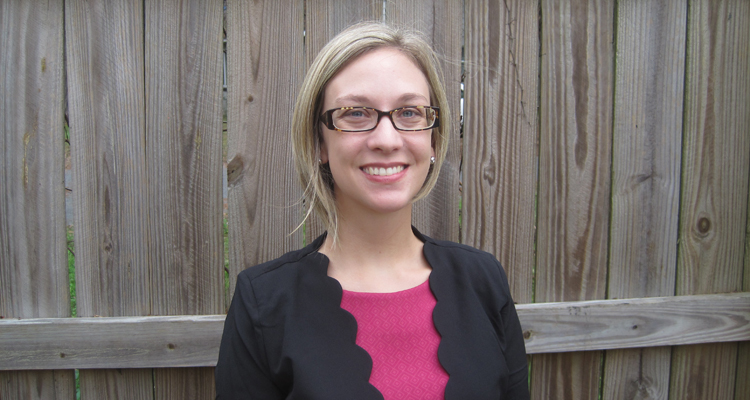Sarah Hayes ’10 M.A. is looking to create conversations. Hayes, a doctorate student at the University of Florida, is preparing to defend her dissertation, which examines the relationship between prisons and American Indian boarding schools.
To Hayes, early American and Native American literature is particularly fascinating because of the conversation opportunities that arise.
“Putting two literatures together, whether Native American or African-American with Euro-American literature, can create conversations about a national narrative, nation building or citizenship,” Hayes said.
Putting the pieces together
Hayes’ interest in early American and Native American literature began at St. Thomas, where she took classes with Heather Bouwman and Elizabeth Wilkinson, and wrote her master’s thesis on Zitkala-Ša. Ša wrote about her experiences at the Carlisle Industrial Indian School. When Hayes arrived at the University of Florida, she took a seminar on prison literature, and began to notice the similarities.
“Prison narratives examined the space of prison and space of the prison cell. It’s very similar to how Ša describes the space of her dormitory,” Hayes said. “Prisons in the 19th century and early 20th century attempted to transform people through architecture and space, and so did the boarding school.”
The more she read, the more Hayes noticed the prison metaphors in contemporary Native American literature. So, she decided to go back to the roots of the American Indian boarding schools and start from the beginning.
“No one really talks about the origins: prisoner-of-war camps,” Hayes said.

Captain Richard Henry Pratt and students at the Carlisle Indian Industrial School. / Yale Collection of Western Americana, Beinecke Rare Book and Manuscript Library
Hayes studied Richard Henry Pratt, founder of the Carlisle School, by looking at his relationship with the prisoner-of-war camp at Fort Marion in St. Augustine, Florida. There, Hayes argued, Pratt experimented with space and the transformation of individuals into citizens. She read Pratt’s autobiography, but also had the opportunity to visit the Beinecke Rare Book and Manuscript Library at Yale University when she was awarded a fellowship. For a month she explored Pratt’s papers, magazine articles and newspaper clippings.
“It was exciting seeing the direct evidence that Pratt was inspired by the second prison reform movement,” Hayes said. She said she found letters where Pratt would write to generals and members of the Bureau of Indian Affairs. “(He thought you could) learn citizenship through labor, education, surveillance and different regimes of the penitentiary. … He created his regimes in St. Augustine and took the regimes to Carlisle.”
Hayes then turned her attention to literature written by the first boarding school students, such as Ša, including Daniel La France and Francis La Flesche. Hayes said these writers often were responding to boarding schools as something being praised. They pointed out how traumatizing and violent the schools were and “challenge(d) the popular characterization of the reservation as a savage space and the boarding school as a civilized space.”
Finally, Hayes examined contemporary Native American literature, looking at writers such as Leslie Marmon Silko and Louise Erdrich.
“What we see is the descendants are remembering and reimagining more of a space for their ancestors to resist the victim narrative. It’s more a narrative of survival and resistance,” Hayes said. They represent the boarding school as a carceral space, she argued.
Still relevant
Hayes is finishing her dissertation and preparing to defend it in April. She hopes to one day turn it into a manuscript. (She also noted that, in the papers she read at Yale, there was mention of how slavery influenced Pratt; she said she might like to explore how slavery was used as a model for assimilation as well.) In the meantime, she’s also job searching, hoping to land a position as an assistant professor so she can keep facilitating those conversations.
She’s taught some classes at the University of Florida already, predominantly early American literature. She pairs the “more canonical” with the “less canonical” to help the class see where they each fall into “the idea of the national narrative, how America was created, for whom it was created and what role people play.”
For example, she taught John Smith’s letters in juxtaposition with Disney’s “Pocahontas.”
“We started conversations about rhetoric and how we create stories for particular audiences,” Hayes said. “We discussed how early stories are reappropriated, and how this story became a part of national mythology when the story isn’t even really true, or at least very exaggerated.”
Even though some of what Hayes has been studying has been around for a long time, she said her work is still relevant today. She noted the American Indian education system is steeped in a long history of colonization and imprisonment, and cited a recent editorial series by the Star Tribune, poignantly titled, “Separate and unequal: Indian schools, a nation’s neglect.”
“I am also hoping that people think about the links between the quality of current Indian schools and the high incarceration rates for Native peoples and how this link is embedded within the history of the boarding school and represented in literature,” Hayes said. “It’s not a new issue. It’s something we’ve needed to address for the last 150 years.”







